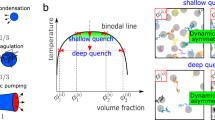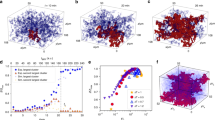Abstract
Concentrated colloidal suspensions and emulsions are amorphous soft solids, widespread in technological and industrial applications and studied as model systems in physics and materials sciences. They are easily fluidized by applying mechanical stress, undergoing a yielding transition that still lacks a unified description. Here we investigate yielding in three classes of repulsive soft solids and find that at the microscopic level, yielding consists of a transition between two distinct dynamical states. We rationalize this by proposing a lattice model with dynamical coupling between neighbouring sites, leading to a unified state diagram for yielding. Employing the analogy with van der Waals phase diagram for real gases, we show that distance from a critical point plays a major role in the emergence of first-order-like versus second-order-like features in yielding, thereby reconciling previously contrasting observations on the nature of the transition.
This is a preview of subscription content, access via your institution
Access options
Access Nature and 54 other Nature Portfolio journals
Get Nature+, our best-value online-access subscription
$29.99 / 30 days
cancel any time
Subscribe to this journal
Receive 12 print issues and online access
$209.00 per year
only $17.42 per issue
Buy this article
- Purchase on Springer Link
- Instant access to full article PDF
Prices may be subject to local taxes which are calculated during checkout





Similar content being viewed by others
Data availability
The data that support the plots within this paper are available via figshare at https://doi.org/10.6084/m9.figshare.22674334. Additional data concerning this study are available from the corresponding author upon reasonable request.
Code availability
The code that supports the plots within this paper and other findings of this study is available via GitHub at https://github.com/steaime/SimulIsing.
References
Bonn, D., Denn, M. M., Berthier, L., Divoux, T. & Manneville, S. Yield stress materials in soft condensed matter. Rev. Mod. Phys. 89, 035005 (2017).
Koumakis, N., Brady, J. F. & Petekidis, G. Complex oscillatory yielding of model hard-sphere glasses. Phys. Rev. Lett. 110, 178301 (2013).
Mason, T. G., Bibette, J. & Weitz, D. A. Yielding and flow of monodisperse emulsions. J. Colloid Interface Sci. 179, 439–448 (1996).
Knowlton, E. D., Pine, D. J. & Cipelletti, L. A microscopic view of the yielding transition in concentrated emulsions. Soft Matter 10, 6931–6940 (2014).
Rogers, M. C. et al. Microscopic signatures of yielding in concentrated nanoemulsions under large-amplitude oscillatory shear. Phys. Rev. Mater. 2, 095601 (2018).
Rogers, S. A., Erwin, B. M., Vlassopoulos, D. & Cloitre, M. Oscillatory yielding of a colloidal star glass. J. Rheol. 55, 733–752 (2011).
Ketz, R. J., Prud’homme, R. K. & Graessley, W. W. Rheology of concentrated microgel solutions. Rheol. Acta 27, 531–539 (1988).
Sollich, P., Lequeux, F., Hébraud, P. & Cates, M. E. Rheology of soft glassy materials. Phys. Rev. Lett. 78, 2020 (1997).
Seth, J. R., Mohan, L., Locatelli-Champagne, C., Cloitre, M. & Bonnecaze, R. T. A micromechanical model to predict the flow of soft particle glasses. Nat. Mater. 10, 838–843 (2011).
Donley, G. J., Singh, P. K., Shetty, A. & Rogers, S. A. Elucidating the G″ overshoot in soft materials with a yield transition via a time-resolved experimental strain decomposition. Proc. Natl Acad. Sci. USA 117, 21945–21952 (2020).
Brader, J. M. et al. Nonlinear response of dense colloidal suspensions under oscillatory shear: mode-coupling theory and Fourier transform rheology experiments. Phys. Rev. E 82, 061401 (2010).
Voigtmann, T. Nonlinear glassy rheology. Curr. Opin. Colloid Interface Sci. 19, 549–560 (2014).
Picard, G., Ajdari, A., Bocquet, L. & Lequeux, F. Simple model for heterogeneous flows of yield stress fluids. Phys. Rev. E 66, 051501 (2002).
Benzi, R. et al. Unified theoretical and experimental view on transient shear banding. Phys. Rev. Lett. 123, 248001 (2019).
Liu, C., Martens, K. & Barrat, J.-L. Mean-field scenario for the athermal creep dynamics of yield-stress fluids. Phys. Rev. Lett. 120, 028004 (2018).
Sainudiin, R., Moyers-Gonzalez, M. & Burghelea, T. A microscopic Gibbs field model for the macroscopic yielding behaviour of a viscoplastic fluid. Soft Matter 11, 5531–5545 (2015).
Keim, N. C. & Arratia, P. E. Yielding and microstructure in a 2D jammed material under shear deformation. Soft Matter 9, 6222–6225 (2013).
Fiocco, D., Foffi, G. & Sastry, S. Oscillatory athermal quasistatic deformation of a model glass. Phys. Rev. E 88, 020301 (2013).
Hima Nagamanasa, K., Gokhale, S., Sood, A. K. & Ganapathy, R. Experimental signatures of a nonequilibrium phase transition governing the yielding of a soft glass. Phys. Rev. E 89, 062308 (2014).
Jeanneret, R. & Bartolo, D. Geometrically protected reversibility in hydrodynamic Loschmidt-echo experiments. Nat. Commun. 5, 3474 (2014).
Kawasaki, T. & Berthier, L. Macroscopic yielding in jammed solids is accompanied by a nonequilibrium first-order transition in particle trajectories. Phys. Rev. E 94, 022615 (2016).
Leishangthem, P., Parmar, A. D. S. & Sastry, S. The yielding transition in amorphous solids under oscillatory shear deformation. Nat. Commun. 8, 14653 (2017).
Edera, P. et al. Deformation profiles and microscopic dynamics of complex fluids during oscillatory shear experiments. Soft Matter 17, 8553–8566 (2021).
Lerouge, S. & Berret, J.-F. Shear-induced transitions and instabilities in surfactant wormlike micelles. in Polymer Characterization Vol. 230 (eds Dusek, K. & Joanny, J.-F.) 1–71 (Springer, 2009).
Cipelletti, L. et al. Universal non-diffusive slow dynamics in aging soft matter. Faraday Discuss. 123, 237–251 (2003).
Madsen, A., Leheny, R. L., Guo, H., Sprung, M. & Czakkel, O. Beyond simple exponential correlation functions and equilibrium dynamics in X-ray photon correlation spectroscopy. New J. Phys. 12, 055001 (2010).
Denisov, D. V. et al. Sharp symmetry-change marks the mechanical failure transition of glasses. Sci. Rep. 5, 14359 (2015).
Divoux, T., Grenard, V. & Manneville, S. Rheological hysteresis in soft glassy materials. Phys. Rev. Lett. 110, 018304 (2013).
Bocquet, L., Colin, A. & Ajdari, A. Kinetic theory of plastic flow in soft glassy materials. Phys. Rev. Lett. 103, 036001 (2009).
Nordstrom, K. N., Gollub, J. P. & Durian, D. J. Dynamical heterogeneity in soft-particle suspensions under shear. Phys. Rev. E 84, 021403 (2011).
Hebraud, P., Lequeux, F., Munch, J. P. & Pine, D. J. Yielding and rearrangements in disordered emulsions. Phys. Rev. Lett. 78, 4657–4660 (1997).
Hohler, R., Cohen-Addad, S. & Hoballah, H. Periodic nonlinear bubble motion in aqueous foam under oscillating shear strain. Phys. Rev. Lett. 79, 1154 (1997).
Petekidis, G., Moussaïd, A. & Pusey, P. N. Rearrangements in hard-sphere glasses under oscillatory shear strain. Phys. Rev. E 66, 051402 (2002).
van Megen, W., Mortensen, T. C., Williams, S. R. & Muller, J. Measurement of the self-intermediate scattering function of suspensions of hard spherical particles near the glass transition. Phys. Rev. E 58, 6073–6085 (1998).
Weeks, E. R., Crocker, J. C., Levitt, A. C., Schofield, A. & Weitz, D. A. Three-dimensional direct imaging of structural relaxation near the colloidal glass transition. Science 287, 627–631 (2000).
Derec, C., Ajdari, A. & Lequeux, F. Rheology and aging: a simple approach. Eur. Phys. J. E 4, 355–361 (2001).
Miyazaki, K., Wyss, H. M., Weitz, D. A. & Reichman, D. R. Nonlinear viscoelasticity of metastable complex fluids. Europhys. Lett. 75, 915–921 (2006).
Hess, A. & Aksel, N. Yielding and structural relaxation in soft materials: evaluation of strain-rate frequency superposition data by the stress decomposition method. Phys. Rev. E 84, 051502 (2011).
Biroli, G. & Garrahan, J. P. Perspective: the glass transition. J. Chem. Phys. 138, 12A301 (2013).
Zausch, J. et al. From equilibrium to steady state: the transient dynamics of colloidal liquids under shear. J. Phys.: Condens. Matter 20, 404210 (2008).
Berker, A. N. Critical behavior induced by quenched disorder. Phys. A: Stat. Mech. Appl. 194, 72–76 (1993).
Bellafard, A., Chakravarty, S., Troyer, M. & Katzgraber, H. G. The effect of quenched bond disorder on first-order phase transitions. Ann. Phys. 357, 66–78 (2015).
Divoux, T., Fardin, M. A., Manneville, S. & Lerouge, S. Shear banding of complex fluids. Annu. Rev. Fluid Mech. 48, 81–103 (2016).
Radhakrishnan, R. & Fielding, S. M. Shear banding of soft glassy materials in large amplitude oscillatory shear. Phys. Rev. Lett. 117, 188001 (2016).
Pham, K. N. et al. Multiple glassy states in a simple model system. Science 296, 104–106 (2002).
Gibaud, T., Frelat, D. & Manneville, S. Heterogeneous yielding dynamics in a colloidal gel. Soft Matter 6, 3482–3488 (2010).
Truzzolillo, D. et al. Overcharging and reentrant condensation of thermoresponsive ionic microgels. Soft Matter 14, 4110–4125 (2018).
Philippe, A.-M. et al. Glass transition of soft colloids. Phys. Rev. E 97, 040601(R) (2018).
Aime, S. et al. A stress-controlled shear cell for small-angle light scattering and microscopy. Rev. Sci. Instrum. 87, 123907 (2016).
Cipelletti, L., Trappe, V. & Pine, D. J. Scattering techniques. in Fluids, Colloids and Soft Materials (eds Fernandez-Nieves, A. & Puertas, A.) 131–148 (John Wiley & Sons, 2016).
Aime, S. & Cipelletti, L. Probing shear-induced rearrangements in Fourier space. II. Differential dynamic microscopy. Soft Matter 15, 213–226 (2019).
Acknowledgements
We thank E. D. Knowlton for help with the experiments on emulsions and L. Berthier for illuminating discussions. This work was funded by the French CNES, ANR (grant nos. ANR-14-CE32-0005 FAPRES (to L.C. and L.R.) and ANR-20-CE06-0028, MultiNet (to L.C. and L.R.)), and by the EU (Marie Skłodowska-Curie ITN Supolen grant 607937 (to S.A. and L.R.)). L.C. acknowledges support from the Institut Universitaire de France.
Author information
Authors and Affiliations
Contributions
S.A., L.R., D.J.P. and L.C. designed the experiments. S.A. performed the experiments and numerical simulations. S.A. and D.T. conceived the model. All authors analysed the results, discussed and improved the model and contributed to writing the paper.
Corresponding author
Ethics declarations
Competing interests
The authors declare no competing interests.
Peer review
Peer review information
Nature Physics thanks Peter Schall, Thibaut Divoux and the other, anonymous, reviewer(s) for their contribution to the peer review of this work.
Additional information
Publisher’s note Springer Nature remains neutral with regard to jurisdictional claims in published maps and institutional affiliations.
Supplementary information
Supplementary Information
Supplementary Figs. 1–17 and Tables 1 and 2.
Rights and permissions
Springer Nature or its licensor (e.g. a society or other partner) holds exclusive rights to this article under a publishing agreement with the author(s) or other rightsholder(s); author self-archiving of the accepted manuscript version of this article is solely governed by the terms of such publishing agreement and applicable law.
About this article
Cite this article
Aime, S., Truzzolillo, D., Pine, D.J. et al. A unified state diagram for the yielding transition of soft colloids. Nat. Phys. 19, 1673–1679 (2023). https://doi.org/10.1038/s41567-023-02153-w
Received:
Accepted:
Published:
Issue Date:
DOI: https://doi.org/10.1038/s41567-023-02153-w
This article is cited by
-
Soft matter in the loop
Nature Physics (2023)



